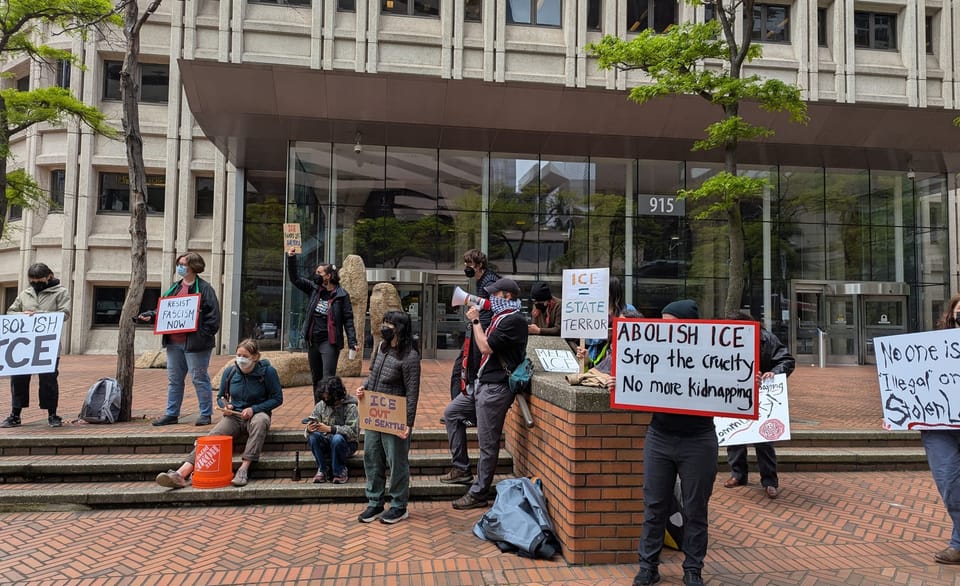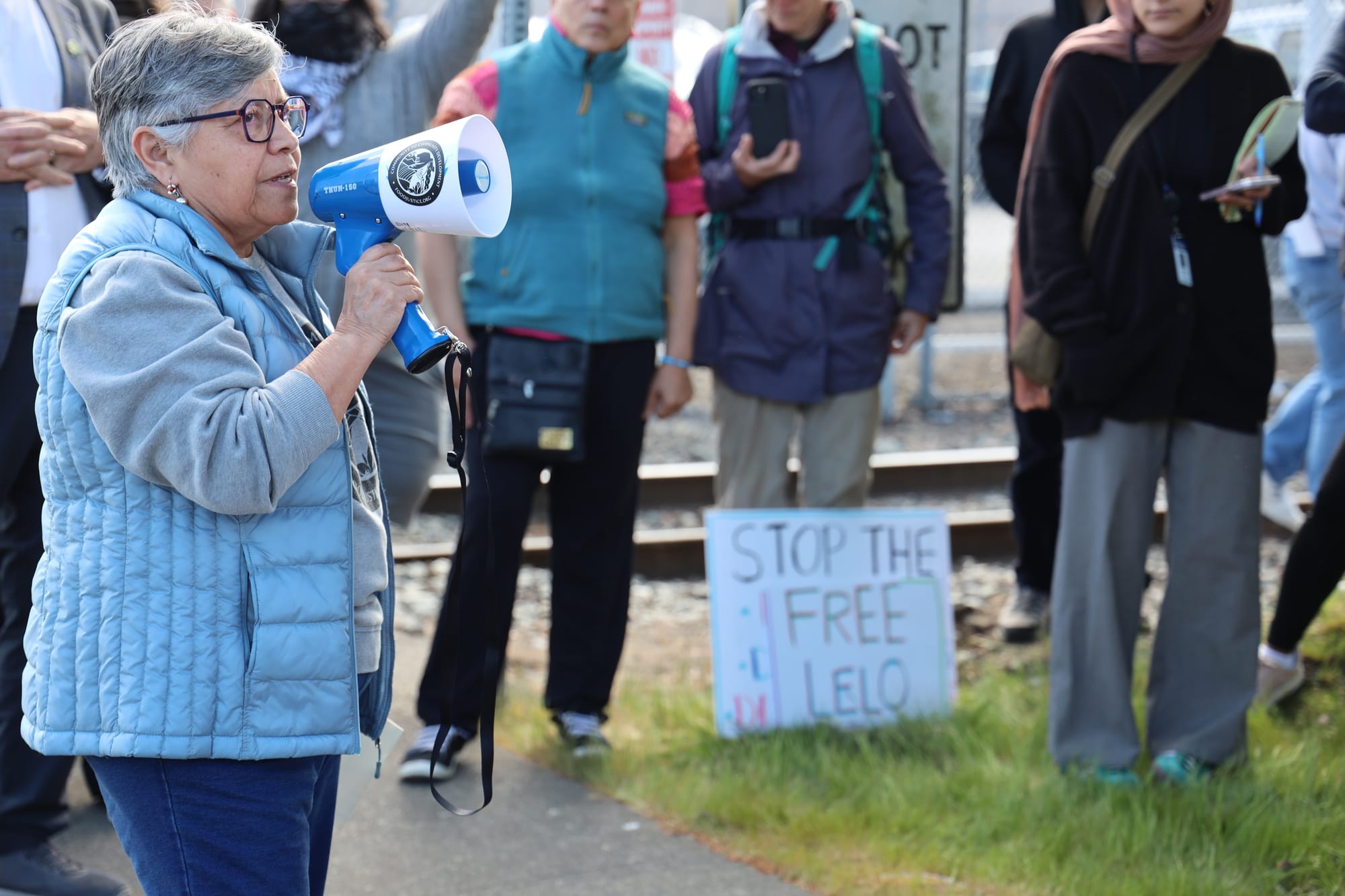Raids, victories and fear: Where Washington stands after almost six months of Trump’s immigration crackdown

Nearly six months into his second administration, U.S. President Donald Trump’s xenophobic crackdown has created an atmosphere of fear and hostility for immigrants in Washington State. But as federal authorities fail to meet expectations, they are increasingly resorting to bolder and more arbitrary methods to fulfill their quotas to achieve the record levels of detention and deportation they were aiming for.
This intensification of enforcement action by Immigration and Customs Enforcement (ICE) and other agencies has in turn sparked backlash and new organizing campaigns by migrants and their allies. However, it remains to be seen whether these efforts will be able to effectively challenge — and ultimately defeat — Trump’s policies.
A hard-won victory
On May 29, 64-year-old Washington permanent resident Lewelyn Dixon was released from the Northwest Detention Center (NWDC). Dixon was met by hundreds of cheering supporters who had relentlessly campaigned for her release. Dixon had spent three months in incarceration at NWDC. She was apprehended by Customs and Border Patrol (CBP) at Seattle-Tacoma International Airport on Feb. 28 while returning from a visit to the Philippines.
Some photos from the rally outside NWDC, courtesy of activists.
— Guy Oron (@guyoron.net) May 29, 2025 at 3:16 PM
[image or embed]
Immigration judge Tammy Fitting granted Dixon’s application to cancel deportation proceedings, ruling that Dixon should be allowed to stay in the U.S.
Dixon’s case galvanized members of the labor movement to forge deeper connections; her release came after months of relentless organizing and mobilization by Filipino community members, her labor union SEIU 925 and other allies. The high-profile arrests like Dixon’s have sparked many Filipino American organizations to form a new alliance, the Tanggol Migrante Network (TMN). Dixon’s with immigration justice networks like TMN. Members of the network visited Dixon on a weekly basis, providing crucial emotional support amid conditions that she described as “hell.”
In a press release by TMN, Dixon’s niece Emily Cristobal said her aunt should have never been detained.
“The biggest thing to realize is she should have never been there in the first place,” Cristobal said. “This is what community looks like, and without all of you, we wouldn’t be here.”
Since Dixon’s arrests, dozens, if not hundreds, of green card and visa holders have been detained. Many of them don’t get the same level of media attention due to a lack of social movement infrastructure.
New tactics
Although ICE under the Trump administration has not yet succeeded in ramping up deportations, it has used new tactics and strategies to target migrants regardless of their legal status.
Immigration authorities are going after any immigrant who has had a criminal record, even if it was nonviolent or from decades ago, as is the case with Dixon and Max Londonio, another Filipino American who was detained by CBP on May 15 as he was returning from vacation at SeaTac Airport.
ICE has also begun loitering outside of immigration courtrooms to arrest people after their hearings. According to KUOW, at least seven migrants were arrested on May 20 and 21 following their immigration court hearings at the Seattle Federal Building. Agents were in plain clothes, wearing surgical masks and gaiter masks to avoid identification.
In response to the new tactic, activists began picketing outside the building and observing its hallways to monitor the presence of ICE agents.
Perhaps the most audacious methods immigration authorities are using to target migrants relate to increased data collection and surveillance. On May 13, a federal judge gave the greenlight for ICE to use Internal Revenue Service (IRS) taxpayer information to locate undocumented immigrants.
This data sharing came to bear on May 20, when ICE raided the warehouse of Kent manufacturer Eagle Beverage, arresting 17 individuals. The Seattle Times reported that the IRS’ Criminal Investigation division participated in the raid.
According to the Washington Immigration Solidarity Network (WAISN), between January and April, 103 people were confirmed to be detained across the state. The organization operates a hotline that allows community members to report immigration enforcement activity.
Toxic status quo
Before Trump was inaugurated, the political environment in the U.S. was already extremely hostile to migrants. Despite pledging to undo many of Trump’s policies from his first administration, former President Joe Biden left the militarized border patrol, detention centers and the Mexico-U.S. border wall largely intact. He presided over a policy of systemic neglect in which millions of refugees — who fled conflict, war and poverty caused by U.S. economic warfare — received no support, leaving communities and local authorities to foot the bill. Biden even went beyond what Trump did in his first administration, signing a draconian executive order that effectively abrogated the right of asylum for hundreds of thousands of newly arriving migrants.
That Biden — like President Barack “Deporter-in-Chief” Obama before him — implemented some more hostile anti-immigration policies than Trump should not be a surprise. Democratic presidents tend to maintain and increase funding for ICE and immigration enforcement, just like Republicans. Famously, in January 2024 Republican Senator Lindsey Graham said that the border security funding package negotiated by Biden was better than anything Trump would be able to achieve if elected. The border funding bill ended up failing due to factional politics.
U.S. immigration politics follow a sad feedback loop of continuous escalation, in which Republican presidents advance xenophobic rhetoric, pushing the boundaries of what is acceptable. After mainstream media begins highlighting the ensuing crackdown, a pro-immigrant opposition coalesces, propelling a Democrat to be elected. But instead of repealing those policies, the Democrats codify their predecessors’ policies, making what was once extreme the new normal.
Politicization of ICE
Across the U.S., approximately 11 million people lack regularized legal status, or about 3.3% of the population. In Washington, around 300,000 people — or about 4% — are undocumented.
Undocumented immigrants lack access to many basic social services and legal rights, despite paying around $100 billion in state, federal and local taxes. Through the implementation of REAL ID, they are barred from air travel and access to federal facilities. Many are forced to work informal jobs or as independent contractors without benefits like health care coverage.
Key sectors such as agriculture and construction rely heavily on this class of undocumented workers, who can be more easily exploited by employers. If the U.S. government wanted to, it could immediately grant legal status to millions who are already integrated into the economy. But, as WAISN policy director Sasha Wasserstrom explained in an interview with Real Change in January, that would undermine the interests of many big corporations.
“What we know is that if we create a stratified society where we have more exploitable groups, it is more beneficial to big business,” Wasserstrom said. “So it is in many employers’ interests to have a group that they are able to pay less than folks who have legal status or who have citizen status because they’re able to get that labor for cheaper and then make bigger profits. So there is a driver here that we in the United States have allowed to grow. That creates an opening for companies to encourage this kind of immigration.”
The contradiction between Republicans’ xenophobia and the economic interests of their wealthy backers helps explain why deportation numbers have not dramatically increased under the second Trump administration. The plan is to scare undocumented people and political opponents into submission.
In fact, immigration enforcement has long been a tool of political repression, dating back to the First Red Scare in the 1920s. With the detention of Palestinian permanent resident and activist Mahmoud Khalil, the use of immigration agencies to crackdown on political dissent is once again in full swing.
One emblematic case that highlights the politics of Trump’s immigration policies is the March 25 arrest and detention of labor organizer Alfredo “Lelo” Juarez Zeferino. Juarez Zeferino helped found Familias Unidas por la Justicia, Washington’s first independent farmworker union in decades. His colleagues say that he was targeted for his influential organizing role and ability to bridge divides and interpret between English, Spanish and Mixtec.

At a rally outside NWDC on May 8, longtime food justice organizer Rosalinda Guillen said that Juarez Zeferino has been a vocal opponent of the H-2A visa program, which allows employers to sponsor migrant workers on short-term stays. The program has been criticized as modern-day indentured servitude, where one’s legal status and rights are almost wholly dependent on their employer. Human trafficking experts have found that the H-2A visa program’s structure creates an environment in which forced labor thrives, and incentivizes third party recruiters who exploit workers. Juarez Zeferino had canvassed growers and employers in the Skagit Valley region, asking them to hire local farmworkers and refuse participation in the H-2A visa program.
“They’re exploiting H-2A workers,” Guillen said. “Lelo Juarez was leading the campaign to stop the H-2A program from coming in and industrializing the workforce in Skagit County.”
Juarez Zeferino was arrested during the H-2A program’s rollout and the ongoing campaigns by farmworkers for fair wages and dignity. It highlights the political stakes of immigration enforcement and the resistance of community members who refuse to live in fear.
This article was updated with edits for clarity.

Member discussion